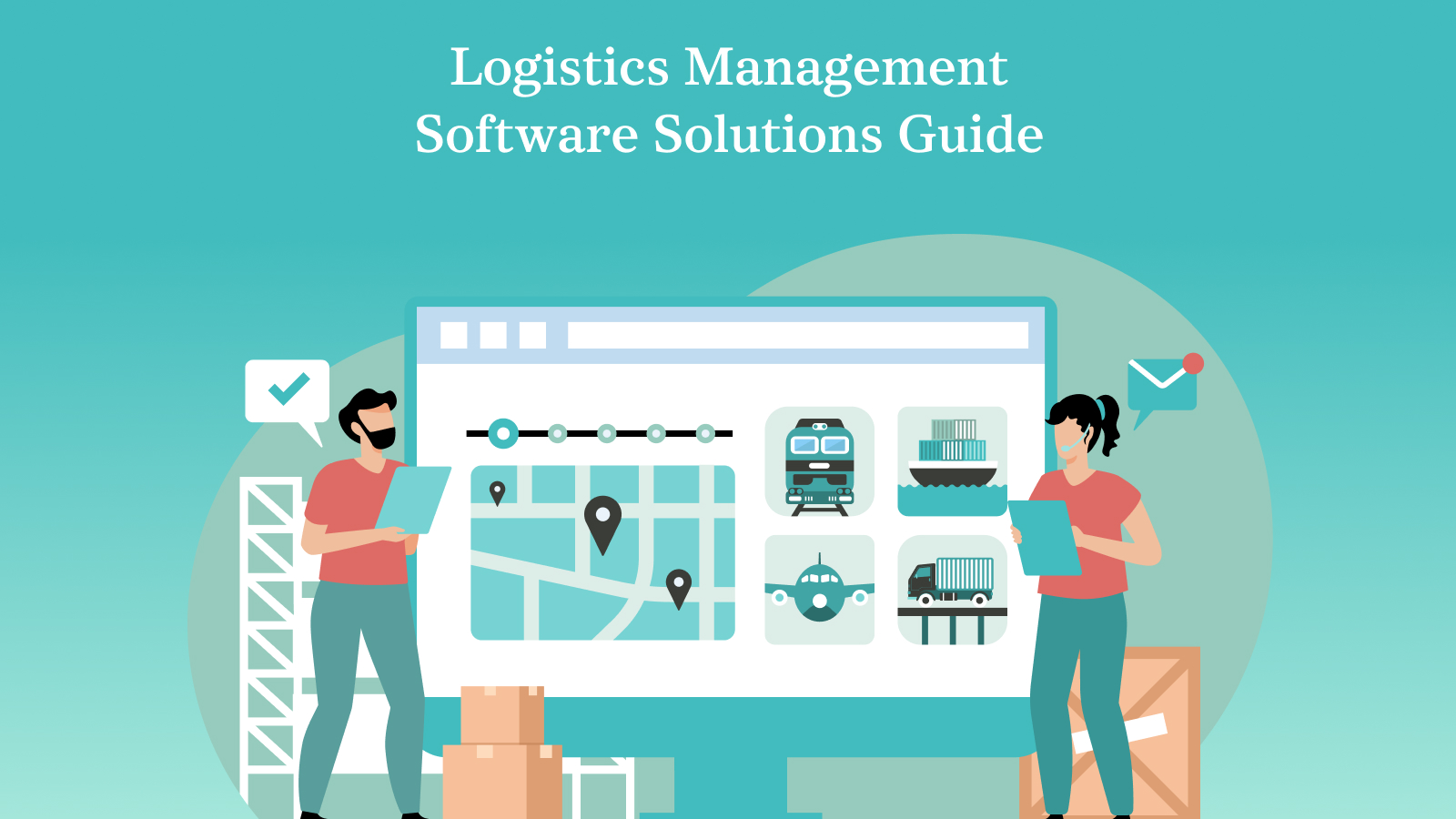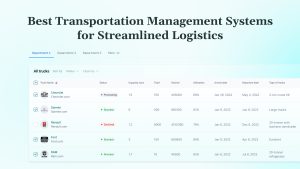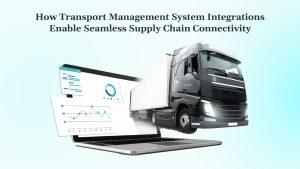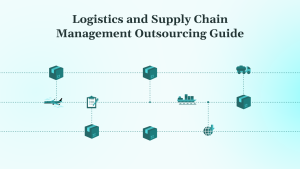The U.S. logistics market was valued at $1.83 trillion in 2024 and is projected to reach $3.81 trillion by 2033, growing at a compound annual growth rate (CAGR) of 8.5%. This expansion is closely tied to the continued growth of e-commerce, automation in supply chain operations, and the rising demand for fast and reliable delivery.
Logistics management solutions have become a necessity for companies seeking to enhance efficiency, minimize costs, and maintain visibility throughout their supply chains. This guide outlines the current challenges, essential features, solution types, selection criteria, and future trends in transport and logistics software solutions.
Key Takeaways
- The U.S. logistics market was valued at $1.83 trillion in 2024 and is projected to reach $3.81 trillion by 2033
- Modern logistics management solutions provide real-time tracking, intelligent routing, and seamless integration with third-party tools.
- Selecting the right software requires a clear understanding of business needs, scalability, and integration capabilities.
- DEVtrust delivers custom, scalable logistics tech, leveraging AI, cloud, and IoT for operational excellence.
- Trends such as AI, automation, and sustainability are shaping the future of logistics management solutions.
- Effective implementation depends on stakeholder engagement, data integration, and continuous improvement.
What is Logistics Management Software?
Logistics management software (LMS) is a digital solution designed to streamline and automate logistics and supply chain operations. It helps businesses optimize the movement of goods, manage inventory, and improve communication across the entire supply chain.
Core features of logistics management software include:
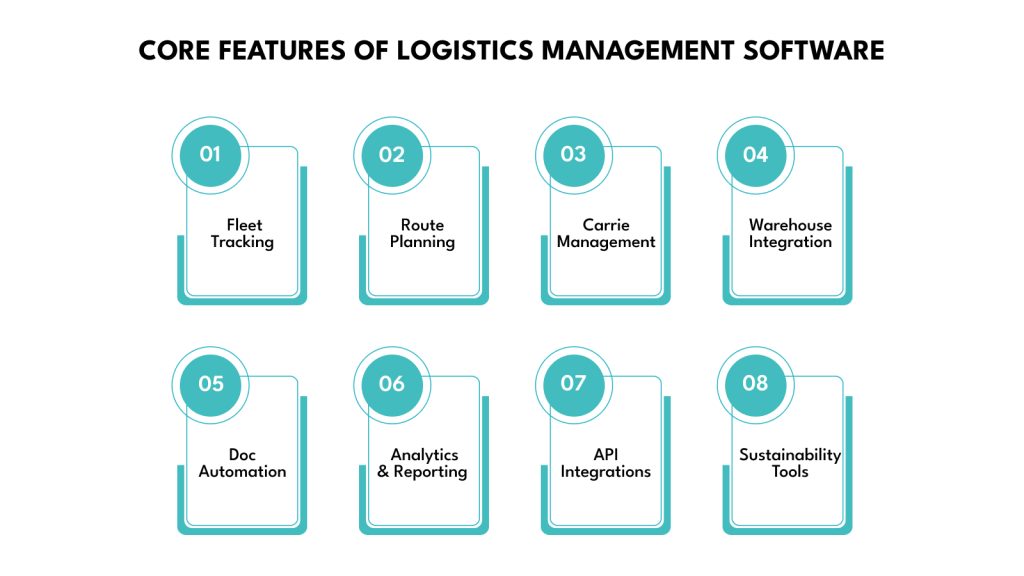
Leading logistics management platforms integrate various functions to enhance operational efficiency and streamline processes:
- Real-Time Shipment and Fleet Tracking: GPS, IoT, and sensor data provide ongoing visibility into vehicle and cargo locations.
- Route Planning and Optimization: Algorithms suggest efficient routes, reducing delays and fuel consumption.
- Carrier and Freight Management: Automated carrier selection and rate comparison streamline the tendering process.
- Warehouse Management Integration: Inventory, order picking, and dispatch are synchronized for faster fulfillment.
- Automated Documentation and Compliance: Digital tools manage bills of lading, customs forms, and regulatory reports.
- Predictive Analytics and Reporting: AI-driven forecasts help anticipate demand, delays, and costs.
- Third-Party API Integrations: Connections with UPS, FedEx, Google Maps, and other services support seamless operations.
- Sustainability Tools: Emissions tracking and green routing support environmental goals.
Next, let’s look at the different types of logistics management solutions available.
Types of Logistics Management Solutions
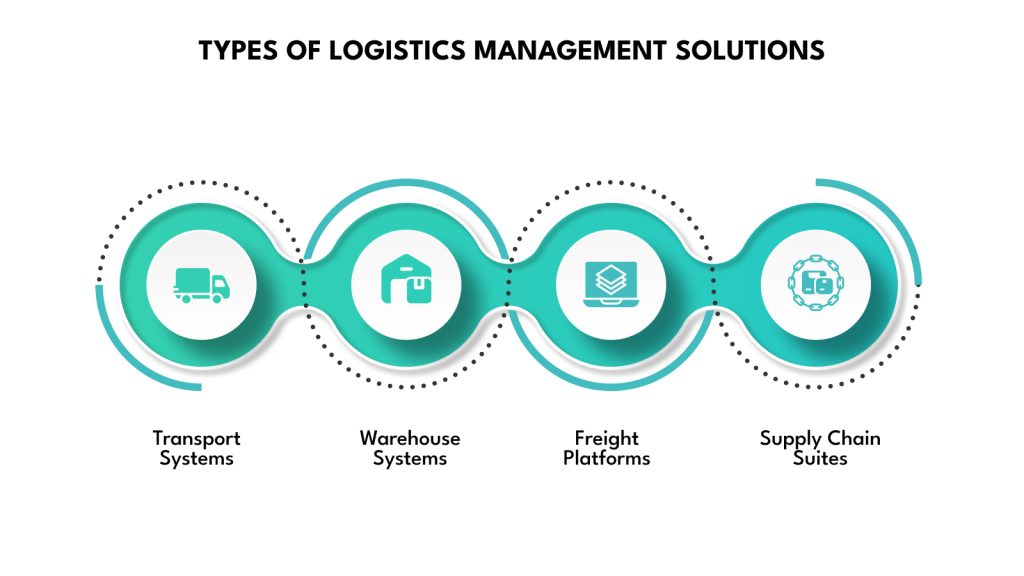
Selecting the right logistics management software depends on understanding the types of software solutions available. Here’s a breakdown of the most common types:
1. Transport Management Systems (TMS)
- Centralized Freight Management: TMS platforms streamline the planning, execution, and optimization of freight movement across multiple transportation modes.
- Key Features:
- Route planning and optimization for fuel savings and timely deliveries.
- Freight audit and payment to minimize errors in transportation costs.
- Carrier selection based on performance and cost.
- Benefits: Reduces transportation costs, enhances shipment visibility, and improves overall supply chain efficiency.
- Example: Used by companies to manage both inbound and outbound logistics, improve on-time delivery, and reduce overall logistics expenses.
2. Warehouse Management Systems (WMS)
- Inventory and Space Optimization: WMS helps businesses manage inventory levels, order fulfillment, and warehouse space utilization.
- Key Features:
- Real-time tracking of inventory movement.
- Automation of picking, packing, and shipping processes.
- Advanced analytics to optimize warehouse layout and product storage.
- Benefits: Enhances order accuracy, reduces stockouts, and increases warehouse efficiency.
- Example: Ideal for e-commerce businesses or manufacturing industries that need real-time visibility and streamlined inventory control.
3. Freight Forwarding Platforms
- Multi-Modal Shipment Management: These platforms handle the logistics of international trade, managing multi-modal shipments from origin to destination.
- Key Features:
- Integration with air, ocean, and road transport for seamless cargo management.
- Document management for bills of lading, customs clearance, and international shipping documentation.
- Shipment tracking with real-time updates for both shippers and customers.
- Benefits: Simplifies the complexities of global shipping, improves communication with carriers, and ensures compliance with international regulations.
- Example: Used by importers and exporters to manage global supply chains, optimize shipping routes, and reduce delivery delays.
4. End-to-End Supply Chain Suites
- Comprehensive Platforms: These solutions integrate procurement, logistics, warehousing, and fulfillment into a single, unified system.
- Key Features:
- Cross-functional integration from supplier management to delivery.
- Real-time data sharing across all departments, including procurement, logistics, and customer service.
- Analytics for end-to-end performance tracking and decision-making.
- Benefits: Provides a holistic view of the entire supply chain, enabling better coordination, cost savings, and improved customer satisfaction.
- Example: Large enterprises or manufacturers often utilize these platforms for full control over their supply chain operations, ensuring timely production and delivery.
Ready to streamline your logistics operations? DEVtrust’s custom solutions, like real-time tracking and route optimization, are designed to fit your needs. Learn how we can help.
Now, let’s examine some of the top platforms leading the industry in 2025.
Top Logistics Management Software Solutions in 2025
Several platforms stand out in the logistics software market due to their robust features and proven results. Here is a comparison of leading solutions:
| Solution | Key Features | Ideal For |
| LogiNext Mile | AI-powered delivery automation, real-time tracking, and dynamic route optimization | Retail, healthcare, e-commerce |
| Descartes | Global trade compliance, shipment visibility | Global shippers, retailers |
| Alpega TMS | Carrier management, analytics, and modularity | Carriers, SMEs, enterprises |
| MercuryGate TMS | Multimodal, analytics, workflow automation | 3PLs, brokers, and large shippers |
| Blue Yonder | End-to-end supply chain, demand planning | Enterprises, manufacturers |
| GoComet | AI-powered, data-driven SaaS, freight procurement | Manufacturers, exporters |
Each of these platforms addresses specific operational needs, from real-time tracking to compliance management and analytics.
With so many software options, choosing the right one can be overwhelming. Here’s how you can make an informed decision.
How to Choose the Right Logistics Management Solution?
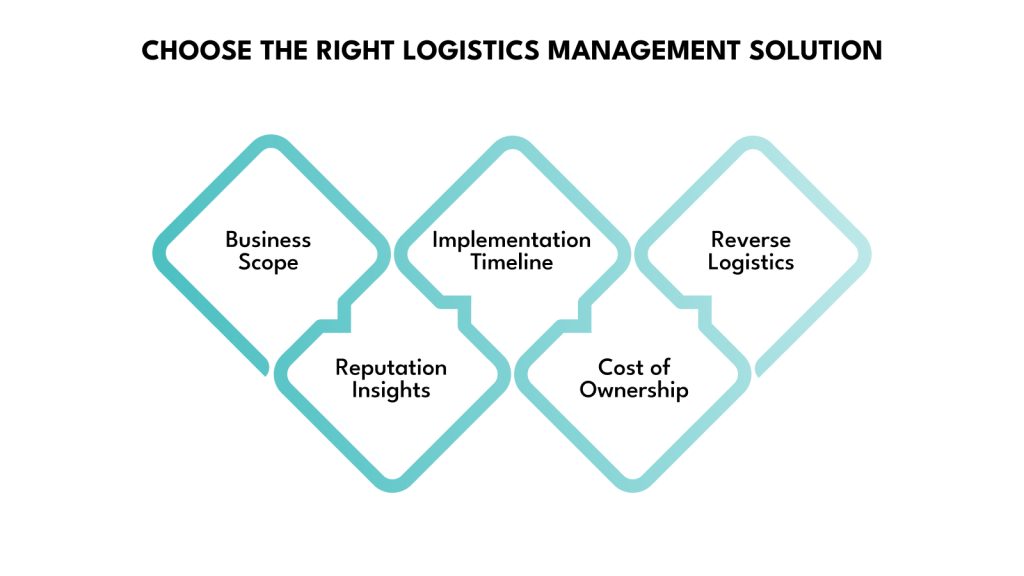
Selecting a logistics management solution requires a structured approach:
1. Business Needs and Scale
Your logistics needs should guide your software selection. Understand your current requirements and future growth trajectory:
- Shipment Volume: Consider whether your business deals with high-volume shipments, which may require more robust software with advanced features.
- Geographic Reach: Evaluate whether the solution supports international logistics and complex routing systems if your operations span multiple regions.
- Growth Plans: Look for scalability to accommodate future expansion and changing logistics demands, such as increased shipments or expanded service areas.
2. Vendor Reputation and Customer Feedback
Assessing the vendor’s reputation and customer satisfaction is crucial:
- Customer Reviews: Platforms like G2 and Capterra offer insights into user experiences, helping you gauge the software’s effectiveness and reliability.
- Case Studies: Reviewing case studies can provide real-world examples of how the software has addressed challenges similar to yours.
- Customer Support: Evaluate the quality and responsiveness of the vendor’s support team to ensure timely assistance when needed.
3. Implementation Timeline and Support
The efficiency of the software’s deployment is vital:
- Implementation Timeframe: Inquire about the typical duration for full implementation to minimize operational disruptions.
- Training and Onboarding: Ensure the vendor provides comprehensive training to facilitate smooth adoption by your team.
- Ongoing Support: Confirm the availability of continuous support post-implementation to address any emerging issues.
4. Total Cost of Ownership (TCO)
Understanding the full financial commitment is essential:
- Licensing Fees: Consider both initial and recurring costs associated with the software.
- Implementation Costs: Account for expenses related to deployment, including any necessary infrastructure upgrades.
- Training and Support: Include costs for user training and ongoing technical support.
- Maintenance and Upgrades: Factor in fees for software updates and system maintenance.
5. Reverse Logistics Capabilities
Efficient handling of returns is a key component:
- Returns Management: Ensure the software can process returns efficiently, including restocking and refunding.
- Quality Control: Implement systems to assess returned items for quality and determine appropriate actions.
- Customer Communication: Maintain clear communication channels with customers regarding return statuses.
Choosing the right software is important, but understanding the challenges that shape your requirements is equally vital.
Key Challenges in Modern Logistics
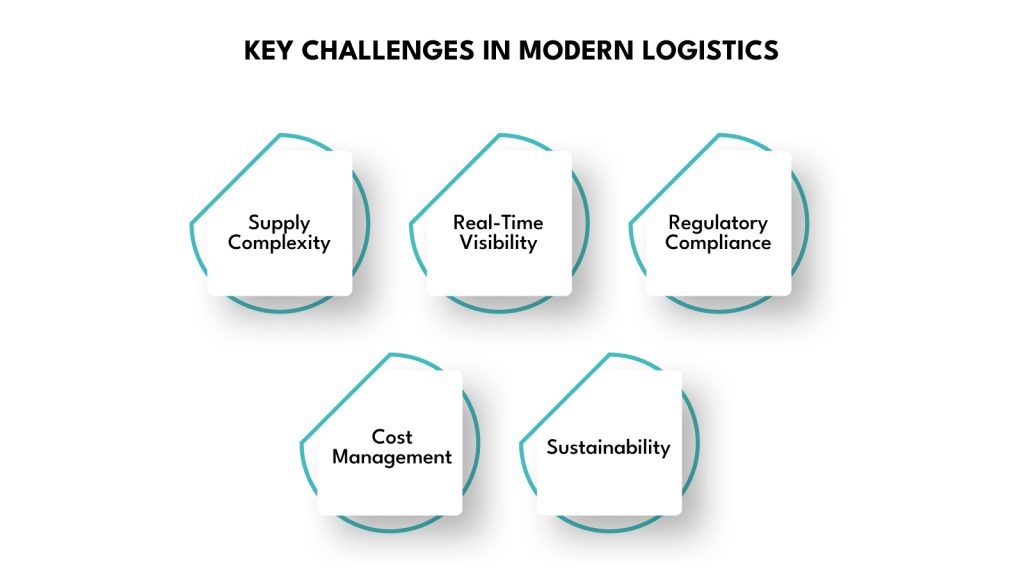
Logistics companies face a series of challenges that shape their software requirements. Below are the key pain points driving the demand for logistics management software solutions:
1. Global Supply Chain Complexity
Managing logistics across international borders requires seamless coordination between multiple carriers and adherence to varying regulatory requirements. This complexity also includes the management of extensive documentation related to customs, tariffs, and shipping laws across regions.
- Cross-Border Coordination: Working with carriers in different countries involves navigating varying standards of service, transportation modes, and tracking systems.
- Compliance Management: Businesses must track international tariffs, trade laws, and regulations to avoid costly delays and penalties.
- Tech Solutions: Solutions such as customized tracking platforms and global supply chain management tools can streamline these complex processes.
2. Real-Time Visibility
As customer expectations evolve, real-time tracking and transparency have become non-negotiable for logistics businesses. The need for continuous updates regarding shipments and product location is vital not only for the end customers but also for internal logistics teams.
- Internal Logistics: Real-time data enables efficient warehouse operations, allowing businesses to identify delays, reroute shipments, and adjust inventory in response to changes.
- Tech Solutions: IoT-enabled tracking and live shipment monitoring systems offer both customers and teams visibility from the moment an item is shipped until it’s delivered.
3. Regulatory Compliance
With the constant change in trade, safety, and environmental regulations, logistics companies must stay up to date with compliance requirements to avoid delays or legal penalties. Changes in laws, such as tariffs, taxes, and environmental standards, impact transportation and logistics operations across borders.
- Trade & Safety Regulations: Navigating through shifting import/export restrictions and safety standards, especially in high-risk areas, requires specialized compliance software.
- Environmental Regulations: As more regulations are introduced to address climate change, logistics companies must comply with local and international sustainability goals.
- Tech Solutions: Compliance management software ensures businesses remain compliant by automatically updating regulations and generating real-time compliance reports.
4. Cost Management
As operational costs continue to rise—driven by fluctuating fuel prices, labor shortages, and increasing transportation demand—businesses must find ways to reduce inefficiencies and cut costs.
- Fuel Costs: Rising fuel costs are one of the top factors driving up overall logistics expenses, especially with unpredictable fuel price fluctuations.
- Labor Management: Labor shortages and rising wages create pressure on logistics companies to optimize workforce management and ensure productivity.
- Tech Solutions: Cost management platforms that integrate fuel tracking, route optimization, and labor efficiency are essential to control overhead costs.
5. Sustainability
With increasing consumer demand for sustainable practices, logistics companies are under pressure to reduce emissions and adopt eco-friendly methods.
- Eco-Friendly Shipping Practices: Companies must look at reducing carbon footprints, using electric vehicles, and optimizing delivery routes to minimize emissions.
- Sustainable Packaging: Switching to recyclable and biodegradable materials helps align with customer values while reducing waste.
- Tech Solutions: Carbon tracking tools and green logistics software enable businesses to measure their emissions and enhance their environmental impact.
Now that we’ve discussed the challenges, let’s explore best practices to address these issues and successfully implement your solution.
Logistics Management Software: Best Practices and Key Considerations
Implementing logistics management software requires careful planning and consideration of advanced features that can improve overall operations. Here’s what to focus on:
Implementing Best Practices
- Stakeholder Alignment: Engage logistics, IT, finance, and customer service teams early to ensure smooth implementation.
- Data Migration and Integration: Plan for secure transfer of historical data and seamless integration with legacy systems.
- Training and Change Management: Offer comprehensive onboarding and ongoing support to encourage user adoption and minimize disruptions.
- Continuous Improvement: Use analytics to refine processes, ensuring continuous optimization and a higher return on investment.
Integration with Existing Systems
Seamless integration with your existing business systems ensures smooth operations and minimal disruption. Key integrations to consider include:
- ERP and Accounting: Sync order, billing, and payment data for efficient financial management.
- CRM: Connect customer data for personalized service and support.
- E-commerce Platforms: Automate order fulfillment, inventory updates, and shipment tracking for online stores.
- Carrier and Supplier Networks: Share data with external partners for coordinated operations.
Security and Compliance
Logistics software must prioritize data security and comply with relevant regulatory standards. Key considerations include:
- Data Encryption: Secure sensitive data in transit and at rest.
- User Access Controls: Restrict access based on roles and responsibilities.
- Audit Trails: Maintain activity records for accountability and compliance.
- Regulatory Standards: Ensure compliance with FMCSA, GDPR, and other relevant regulations.
Measuring ROI from Logistics Management Software
To justify your investment, track key performance indicators (KPIs) that demonstrate the software’s impact on your operations:
- Delivery Times: Reduction in average delivery duration.
- On-Time Performance: Percentage of shipments delivered as scheduled.
- Cost Savings: Lower transportation, labor, and inventory costs.
- Inventory Turnover: Improved stock management and reduced holding costs.
- Customer Satisfaction: Higher ratings and repeat business due to better service.
Looking to take your logistics management to the next level? DEVtrust’s tailored software can optimize your supply chain processes. Book a call to get started.
To stay ahead in the competitive logistics market, let’s look at a few future trends that will shape the industry.
Future Trends in Logistics Management Software
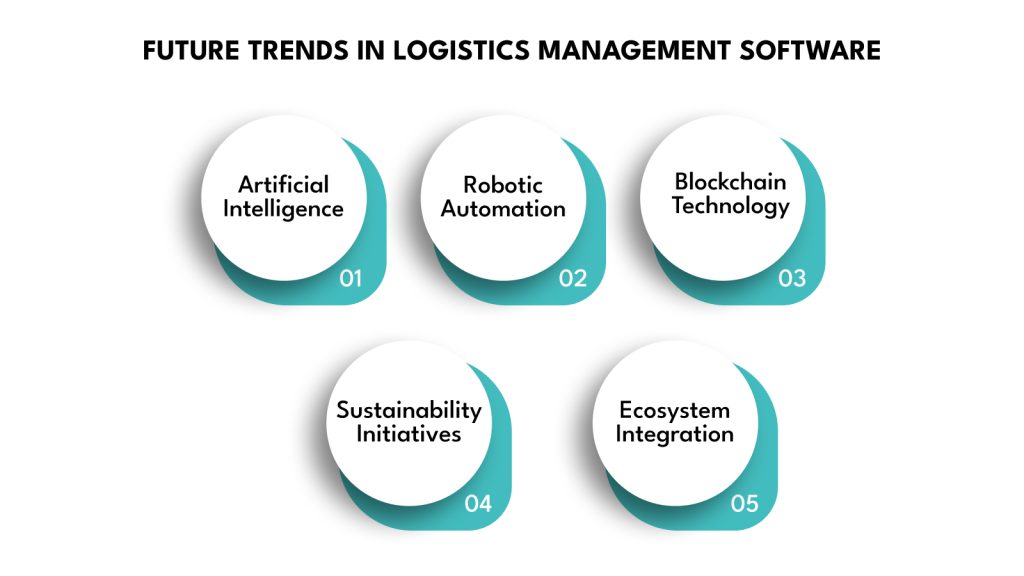
Several trends are shaping the future of logistics management solutions:
1. Artificial Intelligence (AI) and Machine Learning (ML)
AI and ML are reshaping the logistics industry by improving predictive analytics and operational efficiency. Key applications include demand forecasting, inventory management, and optimized routing.
- Market Growth: The AI in logistics market is expected to reach $20.8 billion by the end of 2025, growing at a 45.6% CAGR since 2020.
- Industry Use: Companies like CMA CGM use AI to enhance efficiency, reduce delivery times, and minimize emissions.
2. Robotic Process Automation (RPA)
RPA is streamlining logistics by automating repetitive tasks, improving operational efficiency, and reducing errors. Here’s how it’s being applied:
- Task Automation: Automating order processing, invoicing, and shipment tracking.
- Widespread Adoption: 25% of logistics businesses implemented RPA in 2024, with two-thirds planning to adopt it soon.
3. Blockchain Technology
Blockchain is transforming supply chain transparency and security by providing immutable records. It is increasingly being integrated into logistics software to enhance accountability.
- Transparency: Blockchain ensures secure, traceable transactions across multi-party supply chains.
- IoT Integration: When combined with IoT, blockchain enables real-time tracking and enhances data security.
4. Sustainability Initiatives
With rising environmental concerns, sustainability is becoming a core focus for logistics companies. The industry is prioritizing eco-friendly practices to reduce emissions.
- Emission Reduction: A McKinsey report suggests logistics emissions could be reduced by 40%-50% by 2030 using available technologies.
- Green Practices: Optimizing routes and adopting electric vehicles to lower carbon footprints.
5. Ecosystem Integration
Seamless API integration is key to connecting shippers, carriers, and customers, fostering collaboration, and driving operational efficiency.
- Real-Time Data Exchange: APIs facilitate real-time collaboration and automate processes.
- Enhanced Efficiency: API-driven platforms lead to more resilient and responsive supply chains.
As trends evolve, so does the need for innovation. DEVtrust’s custom logistics solutions ensure your business is always ahead of the curve.
DEVtrust’s Approach to Custom Logistics Tech
DEVtrust specializes in delivering custom logistics software solutions that enhance operational efficiency and scalability. Our services include:
- Custom TMS and WMS Development: We develop Transport Management Systems (TMS) and Warehouse Management Systems (WMS) tailored to your specific workflows, improving efficiency and control.
- API Integrations: DEVtrust ensures seamless integration with essential third-party services, including Stripe, Twilio, Google Maps, and AWS IoT, enabling smooth data flows and enhanced functionality.
- Scalable Cloud Architecture: We deploy solutions on cloud platforms like AWS, Azure, or Google Cloud, ensuring that your logistics infrastructure is robust, reliable, and scalable to support future growth.
- Real-Time Tracking and IoT Integration: By integrating IoT sensors and GPS tracking, we enable proactive management of shipments and fleets, ensuring that you always have real-time visibility and can respond to issues before they escalate.
- AI-Driven Analytics: Our AI-powered solutions deliver predictive insights for enhanced planning, risk mitigation, and operational optimization, enabling you to make informed decisions and improve overall efficiency.
Case Studies: Proven Success in Logistics Tech
Don’t just take our word for it. See how DEVtrust’s custom solutions have optimized logistics operations for real-world businesses.
1. MoveIt4U: Streamlining Container Transport
MoveIt4U, an Australian logistics provider, partnered with DEVtrust to develop a comprehensive logistics platform. Key features included:
- Mobile and Web Applications: Facilitated real-time job tracking and management for drivers and dispatchers.
- Integrated Rate Management: Allowed for efficient cost estimation and invoicing.
- Dynamic Job Matching: Optimized job assignments based on proximity and availability.
This solution enhanced operational efficiency and provided better visibility into logistics operations.
2. Draydex: Revolutionizing Drayage Operations
Draydex, a platform designed for the drayage industry, collaborated with DEVtrust to create a unified software solution. The platform offered:
- Rate Management System: Simplified the process of obtaining and managing drayage rates.
- Carrier Network Access: Connected shippers with a curated network of drayage carriers.
- Market Insights: Provided real-time data and analytics for informed decision-making.
The implementation of this system streamlined operations and improved cost management for users.
Wrapping Up
Selecting the right logistics management solution can dramatically impact efficiency, customer satisfaction, and cost management. As the industry evolves, adopting modern software with AI, machine learning, and blockchain helps businesses streamline processes, reduce costs, and boost performance.
By partnering with DEVtrust, you gain access to custom logistics solutions that are tailored to meet their specific business needs, ensuring scalability, security, and continuous improvement.
Get in touch with DEVtrust to learn how our tailored solutions can optimize your logistics operations, improve real-time tracking, and enhance overall supply chain management.
Want to improve your logistics operations? Connect with us today!
Logistics Management Software Solutions Guide
Explore logistics management solutions to enhance tracking, automate workflows, and improve integration. Uncover strategies for scalability today.
Contact Us